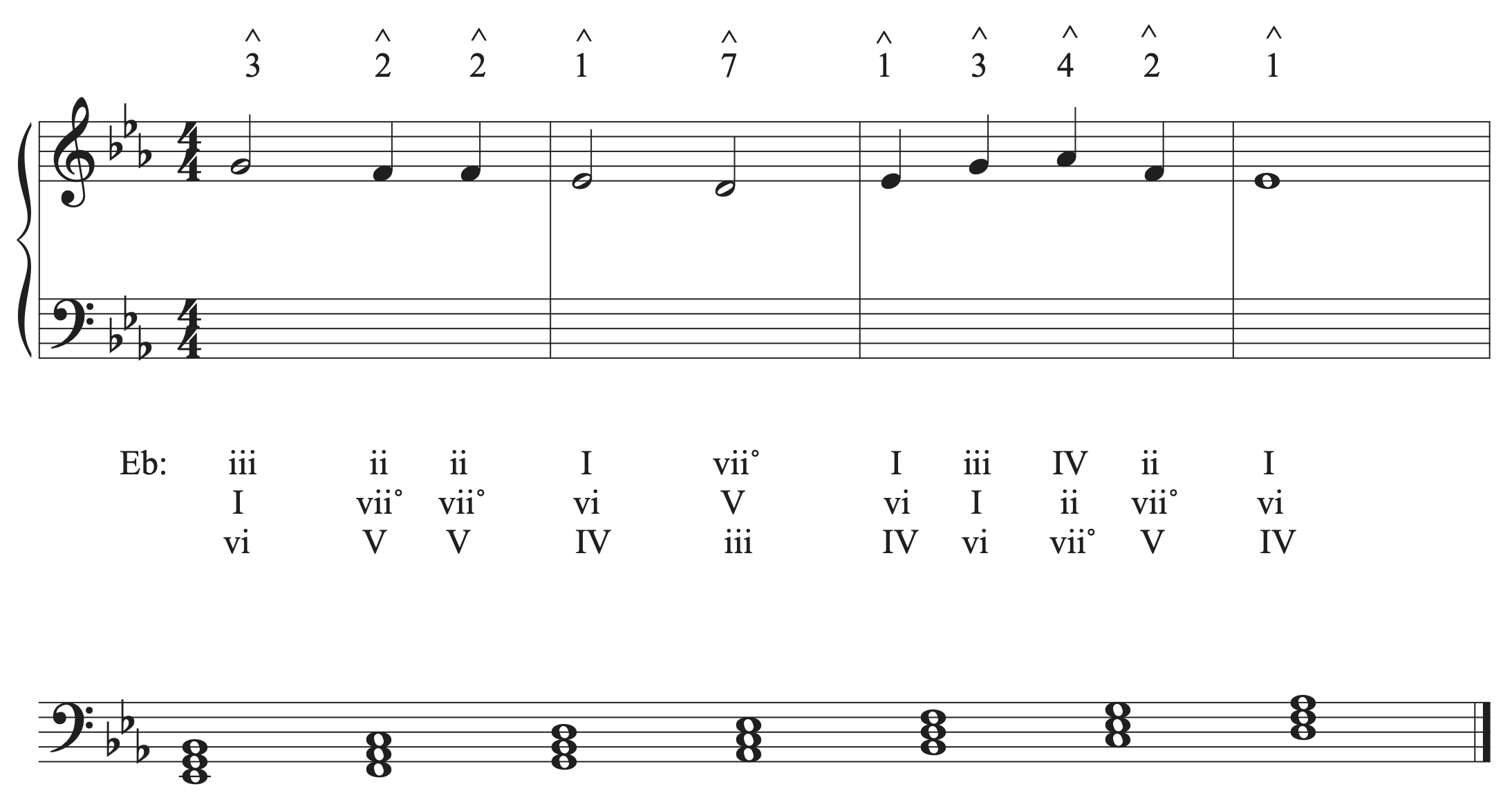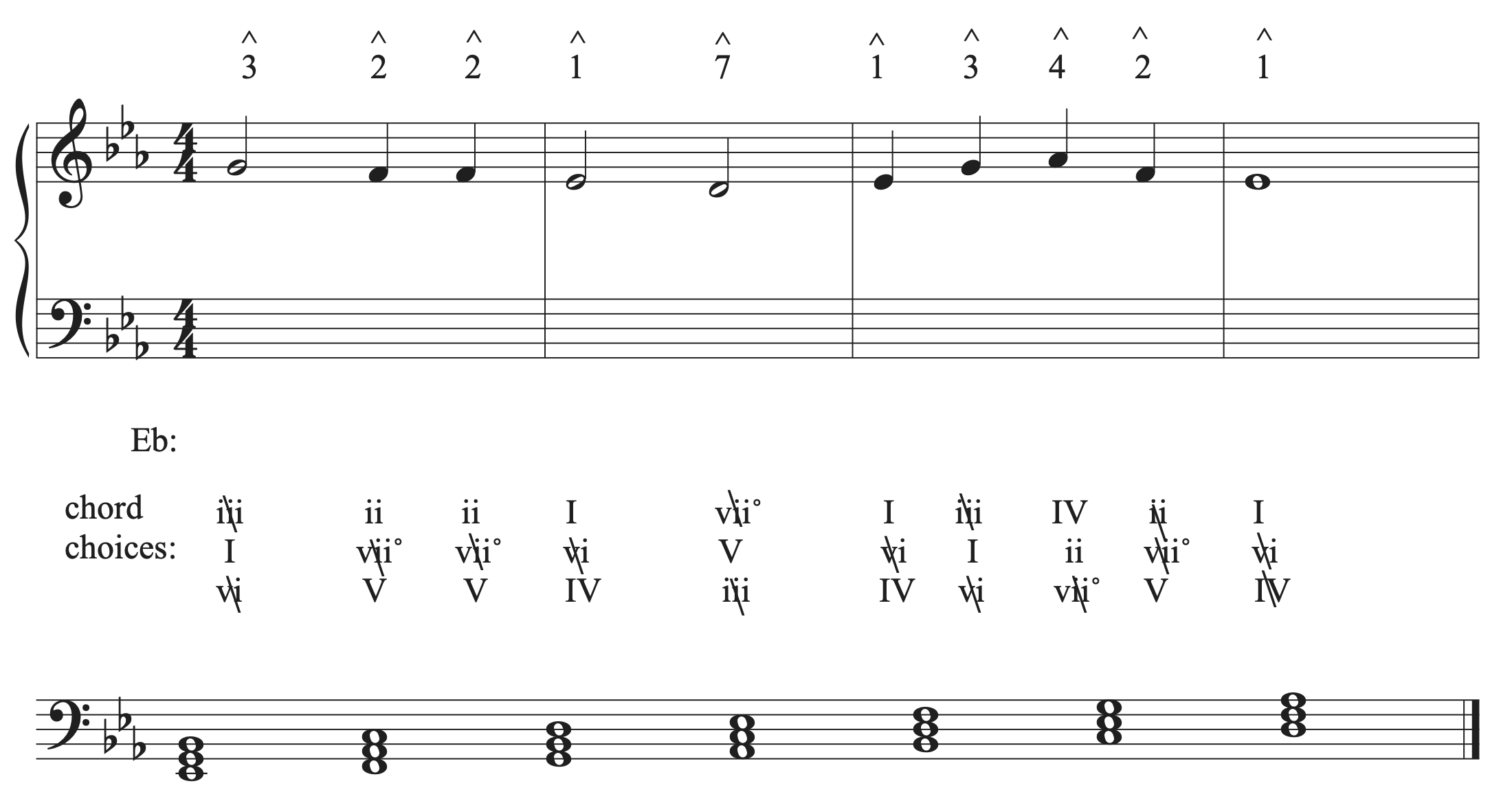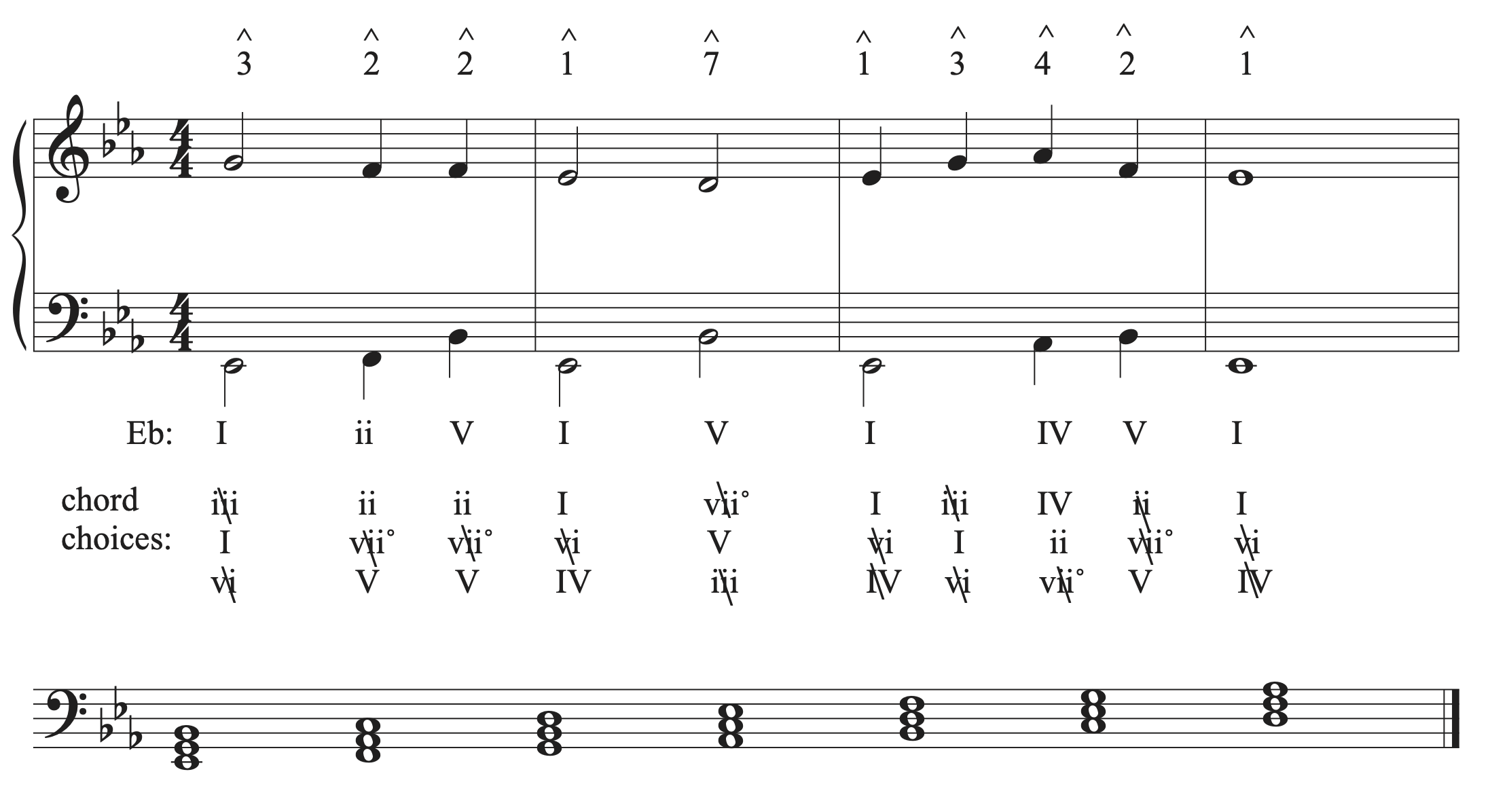11.1 Introduction to Harmonizing a Melody: Theory exercises
Steps for Harmonizing a Melody
This is the general list of steps for harmonizing a melody. The list will become more specific as we explore root position chords, chords in inversions, seventh chords, and non-chord tones.
- Identify the key.
- Write down the chords contained in the key in root position.
- Write in the scale degrees in the soprano voice.
- List chord possibilities under each note in the soprano.
- Identify the melodic phrase structure/cadence points and determine harmonic rhythm.
- Eliminate any chords that cannot be used (either from motion in the soprano, connections between chords, or from choices made in phrasing/harmonic rhythm/cadences).
- Choose a progression (if using inversions, choose chords that create a smooth bassline).
- Write in the bass voice and check for it for errors against the soprano voice before writing the inner voices.
- Part-write the inner voices (make good choices in connecting chords melodically). Check your answers for errors.
Let’s look at an example of how this list is used. The melody below has a melody that we will be using to outline the steps above. Listen to the how the melody sounds. Think about melodic phrasing, cadences, and harmonic rhythm. When do you hear chord changes? When do you hear pauses and endings in the music?

The first steps to harmonizing a melody are to identify the key, and write down a list of the chord used in that key. For our example, we will only use triads in root position.

Next, we write the scale degrees above the soprano pitches. This will help us determine the chords possible on each note of the melody. When working with triads, each scale degree can be used in 3 triads because each soprano note could be the root, 3rd, or 5th of a chord. To quickly list the chords possible on any scale degree, start with the chord that is built on the root of the scale degree, then count backwards two chords in the scale to find the next possible chord, then count backwards from that chord two more in the scale order to find the last possible chord choice. For example, in our melody, we start on scale degree 3. Scale degree 3 is used in a iii chord, a I chord (2 backwards from iii), and a vi chord (2 backwards from I). With practice, knowing what chords are possible on a scale degree will become automatic. The example below shows the three possible chords for scale degree.

Now, think about the melodic form, phrases, harmonic rhythm and cadences. There is a pause in the motion after bar 2, and a conclusive ending in bar 4. Let’s eliminate the chord choices on each scale degree that are not possible to further narrow down our possible progressions and better evaluate harmonic rhythm. We can eliminate anything but tonic for the first and last chords. Since we want the strongest conclusive cadence for the end of the fourth bar, we can eliminate everything other than V-I for our final two chords. Since we are writing in root position, we can eliminate any vii˚ chords because those chords should be used in first inversion. We can also eliminate iii and vi, especially in a root position progression because they are much less frequently used harmonies, and are usually used to expand progressions and connect more structural harmonies. We can also eliminate the IV chord in bar 3 because we are coming from a half cadence on V, and must go to I following the chord on the downbeat in b. 3. The best choice for that is a I chord. Look at the example below with all of the eliminate choices.

Now we can clearly see our options for progressions. In bars 1-2, our choices are:
- I V I V; harmonic rhythm: half note, half note, half note, half note
- I ii IV V; harmonic rhythm: half note, half note, half note, half note
- I ii V I V; harmonic rhythm: half note, quarter note, quarter note, half note, half note
While all of those progressions are possible, I ii IV V is not a great choice because a IV chord doesn’t usually come after a ii chord in a progression. Usually, a IV chord comes before a ii chord. If we eliminate that choice we have to decide between:
- I V I V; harmonic rhythm: half note, half note, half note, half note
- I ii V I V; harmonic rhythm: half note, quarter note, quarter note, half note, half note
Let’s look at the next 2 bars to see what our progression choices look like and how that might influence our choice for bars 1-2. Our choices for bars 2-3 are:
- I ii V I; harmonic rhythm: half, quarter, quarter, whole
- I IV V I; harmonic rhythm: half, quarter, quarter, whole
The harmonic rhythm for both choices is the same. It also mirrors the I ii V I V progression possible in bars 1-2. Since these bars are related and dependent on one another harmonically, the symmetry of the harmonic rhythm works nicely to reflect that change. It also speeds up towards both cadence points, which is a feature of harmonic rhythm in music. Now, we have to decide which progression to use to end the melody. The I IV V I choice is a standard progression in music, it can be part writing smoothly with less worry about potential parallels between I and ii, and it would provide variety from the first two bars that are using a ii chord. So, our final choice for the 4-bar progression is:
- I ii V I V—I IV V I
The next step is to fill in the bass voice and check it for errors with the soprano. You want to catch any errors before you start part writing the entire melody because if you need to change a chord, you will have to erase a lot more of your work. Once the bass line is checked for errors, you are ready to part writing the inner voices.

We will look at the part writing process itself in the next few chapters as we progress from root position chords to adding inversions, seventh chords, and non-chord tones to our melodic harmonizations.

